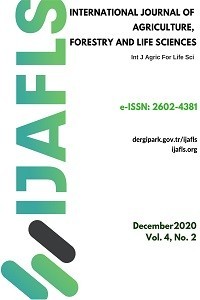EFFECTS OF GLOBAL WARMING ON ANIMAL BREEDING
EFFECTS OF GLOBAL WARMING ON ANIMAL BREEDING
Global warming, Animal production,
___
- Alnaimy,, A. M., Habeeb,I., Fayaz, I., Marai, M., Kamal T.H., 1992. Heat Stress, Farm Animals and the Environment, Clive Philips and David Piggins (Ed). CAB International, 1992. Cambridge, England.
- Atalık, A. 2005. Küresel ısınma, su kaynakları ve tarım üzerine etkileri. http://www.zmo.org.tr/odamiz/kuresel_isinma.pdf (Erisim tarihi: 16.06.2011)
- Beede, D. K. ve Collier, R. J., 1985. Potential Nutritional Strategies for intensively managed cattle during thermal stress. Journal of Dairy Science. 62:543-554.
- Bucklin, R.A.; Turner, L.W.,Beede, D.K.; Bray, D.R.; Hemken, R.W., 1991. Methods to relieve heat stress for dairy cows in hot, humid climates. Dairy Science Abstracts 1991 Vol. 53 No. 9.
- Chase, L. E., Sniffen, C. J., 1988. Feeding and managing dairy cows during hot weather. Feeding and Nutrition. http://www.inform. umd.edu/ Edres/Topic/Agric. Eng.
- Çoban, Y., Darcan, N., Aslan, N., Karakök, S.G., 2008. Türkiye Hayvancılığında Küresel Isınma Ve Olası İklim Değişikliği Etkilerinin Ortaya Konulması. 4. Ulusal Zootekni Öğrenci Kongresi, Mayıs -2008, Samsun, Bildiriler Kitabı.
- Darcan,N., 2005. Hayvansal Üretim Üzerine Küresel Isınmanın Olası Etkileri ve Termal Stresi Önleme Yöntemleri. Hasad Hayvancılık Dergisi, Yıl : 21, Sayı : 243, 27-29.
- Davis, S., Mader, T., Cerkoney, W., 2001b. Managing heat stress in feedlot cattle using sprinklers. Beef cattle report. www. Liru.asft.ttu.edu/pdf/mp76pg77-81.pdf.
- De Rensis, F., Scaramuzzi, R.J., 2003. Heat stress and seasonal effects on reproduction in the dairy cow—a review. Theriogenology, Volume 60, Issue 6, 1 October 2003, Pages 1139-1151.
- De Rensis, F., Marconi, P., Capelli, T., Gatti, F., Facciolongo, F., Franzini , S., et al., 2002. Fertility in postpartum dairy cows in winter or summer following estrous synchronization and fixed time A.I. after the induction of an LH surge with GnRH or hCG. Theriogenology, 2002; 58: 1675–87.
- Drew, B.,1999. Practical nutrition and managment of heifers and high yielding dairy cows for optimal fertility. Cattle Practice, 7: 243–48.
- Doğan S, Özçelik S, Dolu Ö, Erman O. Küresel ısınma ve biyolojik çeşitlilik. Erişimyeri:http://www.researchgate.net/profile/Salih_Dogan2/publication/262914443_Global_warming_and_biodiversity/ links/00b4953c21adae3c17000000.pdf. Erişim tarihi: 28.05.2015.
- Giorgi F, Lionello P. 2008. Climate change projections for the Mediterranean region. Global And Planetary Change, 63(2), 90-104.
- Göncü, S., Özkütük, K., 2003. Shower Effect at Summer Time on Fattening Performances of Black and White Bullocks. J. Appl. Anim. Res. 23 (2003) : 123-127.
- Görgülü, M., Darcan,N.,Göncü,S. Hayvancılık ve Küresel Isınma 2009 V. Ulusal Hayvan Besleme Kongresi (Uluslararası Katılımlı). Çorlu.
- Harner, J.P., Smith, J., Brook, M., Murphy, J.P., 1999. Sprinkler systems for cooling dairy cows at a feed line. Kansas State University Agricultural Experiment Station and Cooperative Extension service. www.oznet.ksu.edu.
- Koluman Darcan, N., Karakök Göncü, S., Daşkıran, İ., 2009. Türkiye hayvancılığının küresel ısınmaya adaptasyonuna yönelik stratejik planlamalar. Ulusal Kuraklık ve Çölleşme Sempozyumu, 16-18 Haziran 2009-Konya.
- Öztürk K.2002. Küresel İklim Değişikliği ve Türkiyeye Olası Etkileri. Gazi Eğitim Fakültesi Dergisi, 22(1).
- Silanikove, N., 2000. Effects of heat stress on the welfare of extensively managed domestic ruminants. Livestock Production Science 67 (2000)1-18.
- Steinfeld, H., Gerber P, Wassenaar T, Castel V, Rosales M, de Haan C., 2006. Livestock’s long shadow: environmental issues and options. Food and Agriculture Organization of the United Nations, p.82-114.
- Switanek M, Brodschneider R, Crailsheim K, Truhetz H. 2015. Impacts of Austrian Climate Variability on Honey Bee Mortality. In EGU General Assembly Conference Abstracts (Vol. 17, p. 9575).
- Şahinler N, Gül A. Akyol E, Yeninar H. 2008. The Effects Of Global Climatic Change OnBeekeeping In Turkey. Apimedica&Apiquality 2nd International Forum.9-12 June. Roma, ITALY. P:19.
- Topal, E.,Özsoy, N.,Şahinler, N.2016. Küresel Isınma ve Arıcılığın Geleceği. Mustafa Kemal Üniversitesi Ziraat Fakültesi Dergisi (ISSN:1300-9362) 21(1):112-120.
- Verge XPC, De Kimpe C, Desjardins RL., 2007. Agricultural production, greenhouse gas emissions and mitigation potential. Agricultural and Forest Meteorology 142:225-69.
- Yayın Aralığı: Yılda 2 Sayı
- Başlangıç: 2017
- Yayıncı: Volkan OKATAN
POLYGENIC RESISTANCE OF IMPROVED RED PEPPER LINES TO PHYTOPHTHORA CAPSICI
Saadet Toğaç, Sermin Akıncı, Bekir Bülent Arpacı
THE USING OF TREES IN HITTITE RELIGIOUS RITUALS
FERTILIZER INPUTS IMPACT OF DIFFERENT BIO-SOLID SOURCES ON SUGAR BEET YIELD IN SANDY SOIL
Ezzat ABD EL LATEEF, Mostafa ABD EL-SALAM, Aziza FARRAG, Gehan AMİN
AN EVALUATION OF NITROGEN FERTILITY MANAGEMENT IN COMMERCIAL POTATO FIELDS
DETERMINATION OF SUITABLE AREAS OF APPLE (MALUS DOMESTICA) CULTIVATION WITH AHP AND GIS TECHNIQUES
Namık Kemal SÖNMEZ, Sahriye SÖNMEZ, Mesut ÇOŞLU, Hasan Raşit TÜRKKAN
EFFECTS OF CALCIUM ASCORBATE AND CALCIUM LACTATE ON QUALITY OF FRESH-CUT PINEAPPLE (Ananas comosus)
Roden TROYO, Antonio Jr. ACEDO
SOME ANIMAL OFFERINGS IN THE HITTITE RELIGIOUS RITUALS
DEVELOPMENT IN SOYBEAN PRODUCTION AND FOREIGN TRADE IN TURKEY
Hilal YILMAZ, Pınar ÇUBUKÇU, Mevlüt GÜL, Ahmet Korhan ŞAHAR, Metin Göksel AKPINAR
AGRICULTURAL DEVELOPMENT LED INDUSTRIALIZATION IN ETHIOPIA: STRUCTURAL BREAK ANALYSIS
Ahmed Kasim DUBE, Wasiu Olayinka FAWOLE, Ramu GOVİNDASAMY, Burhan ÖZKAN
EFFECT OF SEAWEED EXTRACT (SE) ON SEED GERMINATION CHARACTERISTICS OF WHEAT IN SALTY CONDITIONS
